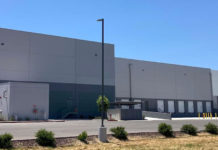Drivers and pedestrians traversing Monterey Street downtown likely notice construction walls and various boarded-up buildings scattered throughout the area. Those who look beyond the shabby exteriors will see a significant amount of investment that could change the face of downtown Gilroy.
Downtown building and property owners, in conjunction with the Downtown Business Association, invited the public on July 19 and 20 to tour five buildings undergoing major seismic retrofits.
The structures, known as unreinforced masonry buildings, contain masonry materials that are not braced by reinforcing beams and pose a safety hazard in an earthquake.
California’s Unreinforced Masonry Building Law since 1986 has required cities located in seismic zone 4—an historically active faultline that runs the length of the California Coast—to inventory their masonry buildings, report the findings to the state and work on getting the buildings up to code.
In 2006, the Gilroy City Council adopted an ordinance identifying 35 buildings constructed with unreinforced masonry, requiring the building owners make the necessary retrofits within three years and imposing a series of fines if such improvements were not made.
That ordinance was amended in 2011, and no longer required property owners to complete full retrofits of their buildings. Instead, it allowed for simpler, less expensive retrofits, including securing URM walls to the roof and floors in multi-story buildings, bracing parapets and repairing or removing façades.
As a result, in the mid-2000s and earlier this decade, many buildings in downtown Gilroy came with an earthquake notice posted on their front door.
“This is an unreinforced masonry building,” the notice read. “You may not be safe inside or near unreinforced masonry buildings during earthquakes.”
Today, most of these buildings are anything but unsafe.
“If there’s a major earthquake, you come here,” said Downtown Business Association President Gary Walton, as he led a group of 20 people into 7533 Monterey St. on July 19.
A new mix of tenants
Building owner Jose Montes said roughly 105 tons of steel has been embedded into 7533 Monterey St., from the foundation to reinforcing the brick walls, resulting in a $1.1 million retrofit of the 10,500-square-foot structure.
Montes also owns the former Hall’s building on the corner of Monterey and West Sixth streets, which is undergoing an $875,000 retrofit. Most of the retrofit work is complete and waiting on PG&E electrical upgrades, which Montes expects within the next eight months.
For 7533 Monterey St., Montes envisions a restaurant at the rear of the building, which faces Gourmet Alley, and a retail shop up front on the Monterey side. A rooftop patio for dining is also being constructed.
Such a restaurant could serve as a catalyst for future food establishments in the aptly named alley, he added.
“We’re looking for someone who will activate Gourmet Alley,” Montes said. “We want to bring some life to Gourmet Alley. That is one of the main goals.”
Realtor John Taft said interest is high in the upgraded buildings among potential tenants. For 7525 Monterey St. in particular, various representatives from restaurants, breweries and retail shops have toured the building.
A food court with an Asian flair is planned for 7320-7340 Monterey St., with four smaller restaurants setting up shop in the building with a common seating area. The building, which was constructed in 1923, is expected to be ready for occupancy by mid-2020.
“This is something different for Gilroy,” Taft said. “This is something different for downtown.”
Downtown rents, which have historically been lower than the rest of the city’s commercial buildings, are starting to see an uptick due to the new investment, he added.
“The market is starting to see the difference in the upgraded buildings,” Taft said. “That helps encourage investment in downtown.”
According to a report by the Downtown Business Association, private and public investment in the downtown totaled $31 million in 2018, highlighted by the $26 million apartment complex constructed on Lewis Street.
The light at the end of the tunnel
The tour comes at a time when city officials softened their stance on URM fines.
On July 1, the city council directed staff to come back with a plan that allows URM building owners the ability to enter into performance agreements, which would waive the penalties and the 10 percent interest that accumulates monthly. Many owners have accrued fines in excess of $100,000.
The council also during that meeting formed a façade improvement program, whereby building owners can apply for a matching grant of up to $5,000 for repairs.
When the city’s ordinance was introduced in 2006, the city identified 35 buildings that were potentially hazardous in the event of an earthquake. That number was whittled down to 17 in 2011, 14 of which have either completed their retrofits or are under construction today. Three buildings have not received their building permits.
“The light at the end of the tunnel is there,” Walton said. “I feel that we are on the verge of seeing more improvement downtown.”














